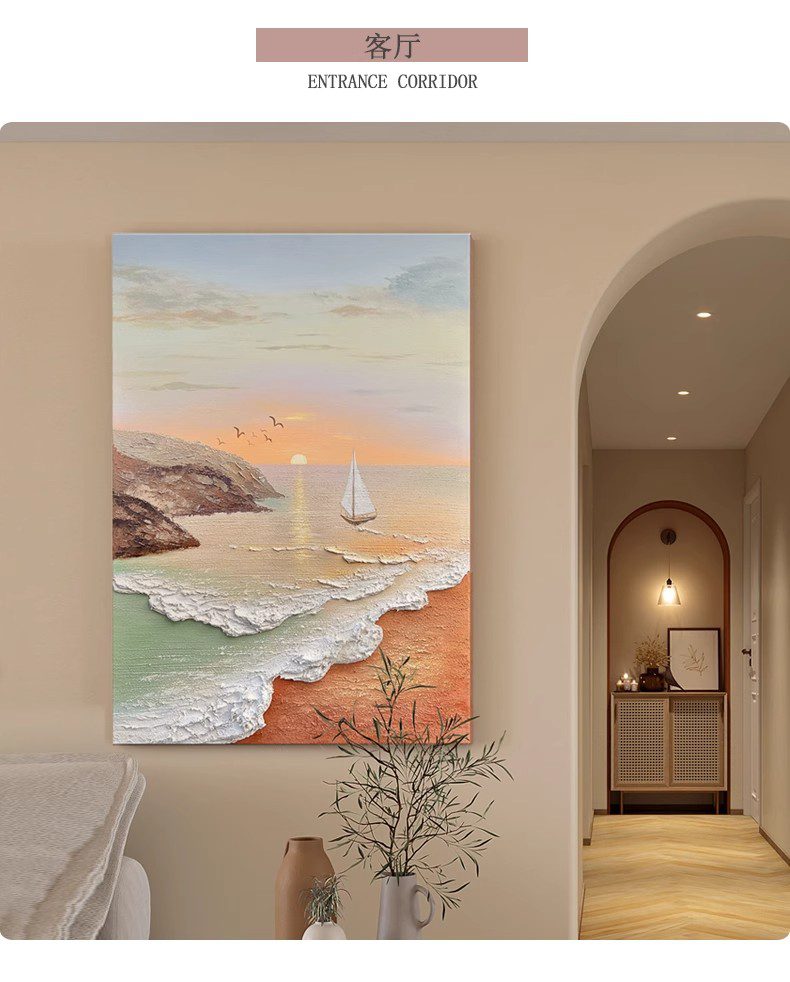Capturing the Essence of Seascapes in Hand-Painted Oil Art: Techniques for Depth and Atmosphere
Painting the ocean demands a nuanced approach to color, texture, and light, as seascapes are inherently dynamic and ever-changing. Below are methods to convey the movement, mood, and vastness of coastal scenes, ensuring your work resonates with authenticity and emotional impact.
Conveying Water’s Movement and Texture
- Brushwork for Varied Surfaces: Use short, choppy strokes with a flat brush to mimic crashing waves, while long, horizontal sweeps create the illusion of calm, glassy water. For frothy crests, layer dry brushstrokes over wet paint to build texture, blending edges softly to suggest translucency.
- Directional Energy: Align strokes with the water’s flow—diagonal lines for ripples caused by wind, or circular motions for whirlpools. This guides the viewer’s eye and reinforces the scene’s energy. For example, painting a tide receding with curved strokes toward the horizon adds rhythm and realism.
- Layering Transparency: Simulate the ocean’s depth by applying thin glazes of blue-green over darker underlayers. Allow each layer to dry partially before adding the next, creating a sense of volume. Lighter glazes near the surface can represent sunlight penetrating the water, while darker tones below suggest mystery.
Mastering Light and Atmosphere on Water
- Time-of-Day Color Shifts: Adjust your palette to reflect natural lighting conditions. A sunrise might blend violet and orange in the sky, with warm pinks reflecting on wet sand and cool blues in shadowed waves. At noon, use crisp whites and grays for highlights on wave peaks, contrasted with deep turquoise in crevices.
- Reflective Surfaces: Treat water as a mirror, duplicating colors and shapes from the sky or shoreline but distorting them slightly. For instance, a cloudy sky reflected in still water will appear softer and more diffused than the original. Use a palette knife to scrape away paint for jagged reflections of rocky cliffs.
- Mist and Fog Effects: Soften distant elements with thin washes of white or gray to imply atmospheric perspective. A sponge dipped in diluted paint can create wispy clouds of sea spray near crashing waves, adding realism and mood. For foggy conditions, mute all colors and blur edges to evoke mystery.
Integrating Coastal Elements to Enhance Narrative
- Rocks and Cliffs as Anchors: Paint weathered rocks with rough, impasto strokes to contrast with smooth water. Use earthy tones like ochre, burnt sienna, and gray for realism, adding moss or lichen with speckled green brushwork. Position cliffs to frame the horizon or lead the eye toward a focal point, such as a distant lighthouse.
- Human and Natural Interaction: Include subtle signs of life—a fishing boat bobbing on waves, seagulls diving for fish, or footprints in the sand—to add scale and story. Paint these elements with sharper details than the surrounding water to emphasize their presence without overwhelming the scene.
- Sand and Tide Lines: Use dry brushing to create the grainy texture of wet sand, varying pressure to show where waves have receded. Incorporate tidal pools with mirrors of the sky or scattered seashells, using warm beige and cream tones to contrast with cooler water hues.
Playing with Perspective and Scale
- Foreshortening for Depth: Tilt the horizon line upward to exaggerate the vastness of the ocean, making distant waves appear smaller and flatter. Paint foreground elements like rocks or driftwood in greater detail to enhance the illusion of depth.
- Aerial Perspective: Soften colors and reduce contrast as elements recede into the distance. A mountain range on the horizon should fade into pale blue, while nearby waves retain vibrant greens and whites. This technique reinforces the ocean’s endless expanse.
- Bird’s-Eye Views: Experiment with elevated vantage points to showcase patterns in the water, such as the geometric shapes of tidal flats or the swirling currents around a pier. Use a limited color palette to unify the scene, focusing on texture and form over detail.
By combining these techniques, you can transform static canvases into living seascapes that pulse with energy and emotion. The interplay of movement, light, and texture invites viewers to feel the salt spray, hear the waves, and lose themselves in the timeless dance between land and sea.
